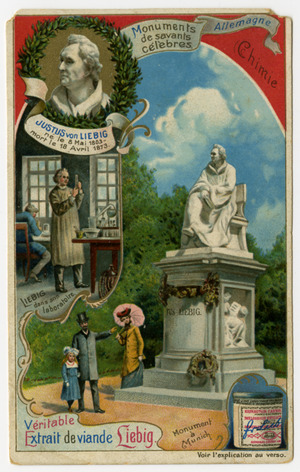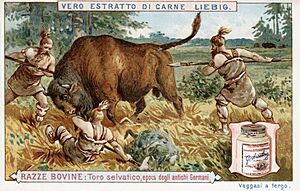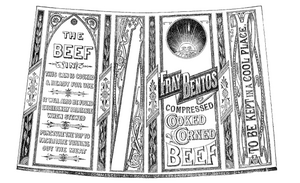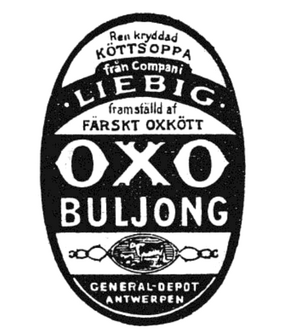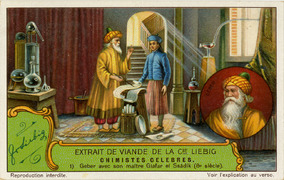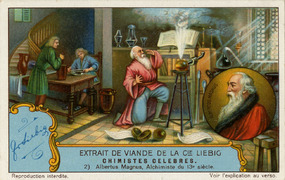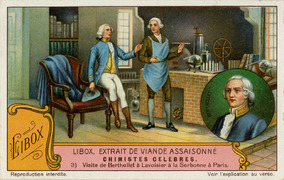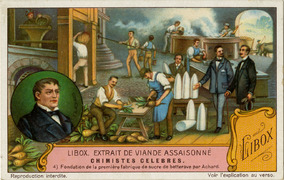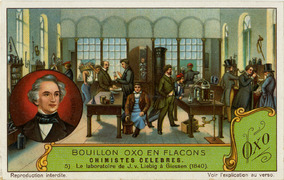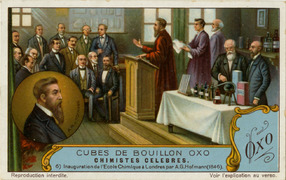Liebig's Extract of Meat Company facts for kids
| Subsidiary | |
| Industry | Food processing |
| Founded | 1865 |
| Founder |
|
| Headquarters | , |
| Products | Meat extract, tinned corned beef, Oxo cubes |
| Parent | Unilever (formerly) |
Liebig's Extract of Meat Company was a famous company from the United Kingdom. It made popular food products like LEMCO (Liebig's Extract of Meat) and the well-known Oxo beef stock cubes. The company was named after Justus von Liebig, a German scientist from the 1800s. He created a way to make meat extract on a large scale.
Contents
How It Started
In 1847, Justus von Liebig invented a concentrated beef extract. He hoped it would be a cheap and healthy food for people who couldn't afford fresh meat. His method involved boiling meat with water and then reducing it to a thick paste.
However, making this extract in Europe was too expensive because meat cost a lot. Liebig shared his invention with everyone, hoping it would help many people. Several small companies started making meat extract using his ideas.
In 1862, a young German engineer named George Christian Giebert read about Liebig's work. He believed the process could be done cheaply in South America. There, cattle were often killed just for their hides, and their meat was wasted. Giebert thought he could use this meat to make extract at a much lower cost.
Liebig agreed with Giebert's plan. With help from other business people, Giebert built a test factory in Fray Bentos, Uruguay. By 1864, they had already sold a lot of extract. In 1865, Liebig joined the company as a director. The Liebig Extract of Meat Company officially started in London on December 4, 1865. Liebig himself checked the quality of the product. This partnership helped the company claim it was the official maker of Liebig's meat extract.
Other companies also tried to use the name "Liebig's Extract of Meat." To stand out, Liebig's company started using the name "LEMCO" in Britain. They put this new trademark clearly on their products. This helped customers know they were getting the real product.
Company Products
Liebig's meat extract was a dark, thick spread, like molasses. It came in a white glass bottle and contained reduced meat stock and salt. It took about 30 kilograms of meat to make 1 kilogram of extract.
At first, the extract was promoted as a healthy and cheap food. However, later studies showed it didn't have much fat or protein. Experts realized it wasn't a main source of nutrition. So, the company changed its marketing. They started focusing on how convenient and flavorful the extract was. It became known as a comforting food and a stimulant.
The product became very popular, especially in European homes. By 1875, the Fray Bentos factory was making 500 tons of extract each year. Soldiers used it during the American Civil War and World War II because it lasted a long time and was easy to carry. Today, Liebig Benelux still sells it.
In 1873, Liebig's started making tinned corned beef under the name Fray Bentos. Later, with new freezing technology, the company also began exporting frozen meat. The huge amount of food processed there made Fray Bentos known as "The Kitchen of the World."
Fray Bentos canned meats are still sold in Europe today by Baxters. The brand also makes meat pies, which started in 1958.
The company also worked with a chemist named Henry Enfield Roscoe to create a cheaper meat extract. This product was called "Oxo." It was first a liquid, then in 1911, it became the famous bouillon cubes we know today.
The Fray Bentos Factory Complex
The factory complex in Fray Bentos, Uruguay, was one of the biggest industrial sites in South America. It helped bring the industrial revolution to the region. The city of Fray Bentos grew alongside the factory. The plant was very important for Uruguay's cattle industry, which is still a major export today.
Many European immigrants came to work there. At its busiest, the factory had 5,000 employees. It's said that an animal was processed every five minutes, and every part of the animal was used.
In 1964, a typhoid outbreak in Aberdeen, Scotland, was linked to Fray Bentos corned beef. Investigations showed that the cooling water used in canning wasn't always being cleaned properly. This, along with Britain joining the Common Market, hurt sales. In 1971, the factory was given to the Uruguayan government. Production stopped completely in 1979, which was a big loss for the people living there.
Company Changes Over Time

In the 1920s, Liebig's Extract of Meat Company bought the Oxo Tower Wharf in London. They built a factory there, keeping the original riverside part of the building.
In 1924, the company was bought by the Vestey Group. The factory was renamed Frigorífico Anglo del Uruguay. Liebig's later merged with Brooke Bond in 1968. Then, Unilever bought Brooke Bond in 1984. Over the years, parts of the company and its brands like Oxo were sold to different food companies. Today, the brands are owned by various companies around the world.
Museum of the Industrial Revolution
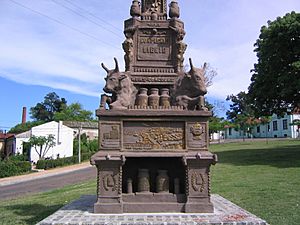
The Museo de la Revolución Industrial (Museum of the Industrial Revolution) is now located in the old factory complex at Fray Bentos. This museum shows the original machines and tells the story of the factory and the people who worked there. It's a way to preserve the history of this important industrial site.
The museum is open for visitors and students. You can see the machinery used for processing meat and making extract. There's also an old water pumping machine from 1893, a canning plant, and a laboratory. The museum has hundreds of photos showing what working life was like at Liebig's. The site has even been suggested as a possible UNESCO World Heritage Site.
Cookbooks and Marketing
Liebig's company worked with popular cookbook writers to make their products famous. Writers like Henriette Davidis in Germany and Hannah M. Young in England created recipes using Liebig's extract. These cookbooks helped people learn how to use the products in their daily cooking.
Trading Cards
Liebig's also used colorful calendars and trading cards to advertise their products. They made many different kinds of advertising items, like table cards, menu cards, and children's games. In 1872, they started including sets of trading cards with their products. These cards featured stories, historical facts, and information about different places. Many famous artists designed these cards. They are still popular with collectors today.
Famous Chemists Trading Card Set
A typical set of trading cards had six cards, all on the same topic. One set featured famous chemists, both old and new. One card even showed Liebig in his laboratory with his students.
-
Geber (Jābir ibn Hayyān)
-
Justus Freiherr von Liebig's Laboratory in Giessen
See also
 In Spanish: Liebig's Extract of Meat Company para niños
In Spanish: Liebig's Extract of Meat Company para niños


